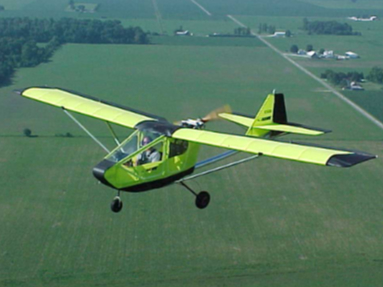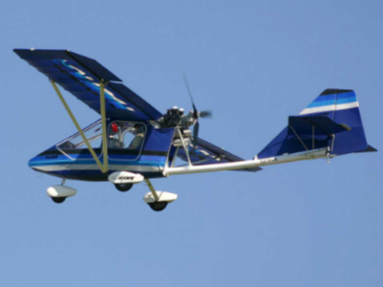
The Hawk Classic Two Seat was designed for those who wanted the excellent flight and handling characteristics of our Hawk Classic Single Seat, but needed to carry a passenger or give flight instruction. The Hawk Classic Two Seat easily fits the requirements of Part 103-7 Waiver for Two Seat Instruction. With an empty weight of 395 lbs. equipped with a Rotax 503 and 440 lbs. equipped with a Rotax 582 (electric start and brakes), we are well under the weight limit of 490 lbs.
The Hawk Classic Two Seat incorporates tandem seating rather than side by side. This allows a student to feel as if he is flying in a single place during his all important instructional phase because the instructor is out of sight and behind him. When it is time to solo, the student pilot experiences more confidence and less stress with this seating arrangement. He is not suddenly dealing with an empty seat next to him. With tandem seating, turns to the left or right are equally comfortable because you don't have to look across a seat to check behind you. In addition, since most ultralight aircraft are pushers, the tandem configuration allows for better inflow to the propeller, and much less drag. Center of gravity changes are also much less pronounced when flying solo vs. with a passenger. In a tandem set up, the front pilot balances the engine, and the passenger sits on the center of gravity, so it makes no difference if you have a passenger or not. The center of gravity changes very little. In a side by side arrangement, however, when the passenger exits the plane, the center of gravity makes a drastic shift to the rear, and must be compensated for in some way.
On the Hawk Classic Two Seat the rear seat is designed to sit slightly higher than the front seat so the field of vision of the passenger or instructor in the rear seat is not obstructed. Other design features of the Hawk Classic Two Seat include: the wing design has a double surface flat bottomed airfoil for stable flight characteristics. The nose is rounded on the bottom and the windshield has a flatter angle than the CGS Hawk Arrow models. Flaps (not flaperons) are standard equipment on all Hawks and are very effective in increasing climb rate and decreasing landing distance. At the heart of the Hawk's unique design is its curved boom tube (which has never been successfully copied by any other ultralight manufacturer). The curved boom allows the horizontal stabilizer to be placed up and above the down wash of the wing, especially when flaps are deployed. Another benefit of the curve is shorter landing gear legs making it easier to get in and out of your plane. The curved boom also is stronger in torsion than a straight boom, and allows the airplane to rotate for take offs and landings in a normal fashion without banging the boom on the ground. It is also aesthetically pleasing to look at.
Source: cgsaviation.com
